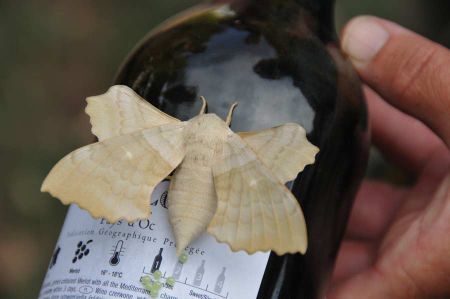Silk Moth- oviposition on a Merlot wine bottle
- Written by Portal Editor
After another long hike through the mountains of Galicica National Park on Lake Ohrid, Sven had invited us for an evening barbeque, which we gladly accepted.
Our day's hike was quite tiring but also quite informative and the route was more interesting then expected, so that we all were waiting for a pleasant evening with delicious grilled food and a glass of wine, enjoying the reviews of the day and relax.
Little later Sven was back with a bottle of Merlot in his hand, taken from his "camper mobile" as he, visibly surprised, pointed to a "powerful looking type of flying object", which landed on the wine bottle. Of course, we directed all our attention to the bottle in his hand, because the flying object made no attempt to move away again. A wine connoisseur among the Moth?
Even as we approached with the camera, the animal remained sitting quietly - yes, it even began to lay eggs on the wine bottle, very strange. Even more campers from the spot, which could be clearly assigned the animal as Silk Moth female, were explaining that its death was probably very close because female moth die after ovipositioning. The first yellow eggs will soon darken and finally they will be gray. They are then oval, flattened, 1 to 1.5 millimeters long and colored slate gray, the color does sometimes bluish, violet or green. Unfertilized eggs remain yellow and dry out. The fertilized eggs hatch silkworms after wintering. The pairing of silkworm butterflies lasts six to eight hours. After pairing the female moth lays about 400 eggs in a few days.
As silkworm, originally from China, several other butterfly species are referred to, which are also used for the production of silk. Including the Samia Cynthia (Samia cynthia), which lives on the leaves of the ailanthus tree.
Human beings early in history learned the capabilities of the caterpillars of the silk moth for the production of silk. It was then spread outside its original habitat, including Southern Europe for silk production.
The caterpillar is pearl gray after the first molt, partly to brown, sometimes tending towards yellow. The silkworm sheds its skin four times and 30 to 35 days after hatching from the egg is ripe to spin. The silk glands of the bead made of a tortuous tube whose rear part creates the secretes, which consists of proteins silk substance. The silk material is passed through thin ducts to head spinneret and from there out of the body. The material of the spinneret substance hardens in the air at once.
During material exits, the caterpillar makes specific head movements, it lays yarn for yarn winding around them. After the initial discharge of an irregular, loose fiber mass, the "silk worm", it is enclosed by a thick silk cocoon in a short time. This cocoon consists of a single up to 900 meters long thread. The cocoon is elongated-oval, straw-yellow in the native breeds, the Japanese breeds greenish, white on white spinners. Eight days later, the animal is pinning to chrysalis silkworm, after another eight days it hatches to butterfly, when it dissolves the cocoon by a brownish liquid.
We have then, due to our hunger, finished our considerations about silkworm, placed the bottle of Merlot carefully aside and embarked on our camping tables. Instead of wine, there now was a beer after the exiting days, good as well. The next morning our silkworm was gone. Maybe the bottle was not such a good nesting site.
Please read as well:
Young Swallows in the nest - shouting we are hungry
Chameleon at Oymapinar Dam - Manavgat
-
 Silk Moth on Merlot Wine Bottle
Silk Moth on Merlot Wine Bottle
Silk Moth on Merlot Wine Bottle
Silk Moth on Merlot Wine Bottle
-
 Silk Moth on Merlot Wine Bottle
Silk Moth on Merlot Wine Bottle
Silk Moth on Merlot Wine Bottle
Silk Moth on Merlot Wine Bottle
-
 Silk Moth on Merlot Wine Bottle
Silk Moth on Merlot Wine Bottle
Silk Moth on Merlot Wine Bottle
Silk Moth on Merlot Wine Bottle
-
 Silk Moth on Merlot Wine Bottle
Silk Moth on Merlot Wine Bottle
Silk Moth on Merlot Wine Bottle
Silk Moth on Merlot Wine Bottle
-
 Silk Moth on Merlot Wine Bottle
Silk Moth on Merlot Wine Bottle
Silk Moth on Merlot Wine Bottle
Silk Moth on Merlot Wine Bottle
-
 Silk Moth on Merlot Wine Bottle
Silk Moth on Merlot Wine Bottle
Silk Moth on Merlot Wine Bottle
Silk Moth on Merlot Wine Bottle
-
 Silk Moth on Merlot Wine Bottle
Silk Moth on Merlot Wine Bottle
Silk Moth on Merlot Wine Bottle
Silk Moth on Merlot Wine Bottle
-
 Silk Moth on Merlot Wine Bottle
Silk Moth on Merlot Wine Bottle
Silk Moth on Merlot Wine Bottle
Silk Moth on Merlot Wine Bottle
-
 Silk Moth on Merlot Wine Bottle
Silk Moth on Merlot Wine Bottle
Silk Moth on Merlot Wine Bottle
Silk Moth on Merlot Wine Bottle
https://www.alaturka.info/en/life/fauna/3214-silk-moth-oviposition-on-a-merlot-wine-bottle#sigProIdeda542931b

